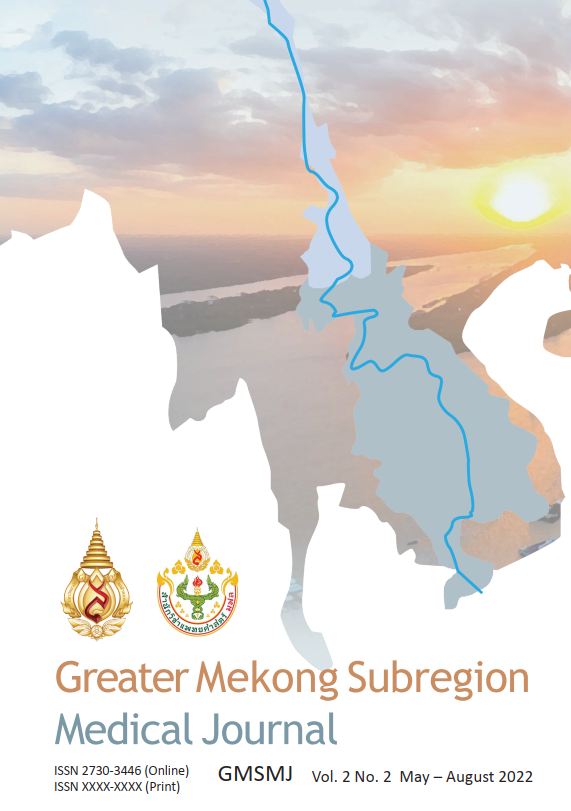Self-Administered Moxibustion of Dyslipidemia in Diabetic Patients: A Randomized, Double-Blind, Controlled Trial
Keywords:
Acupuncture, Moxibustion, DyslipidemiaAbstract
Background: Dyslipidemia is a common disease and a public health problem. Dyslipidemia is one of the leading risk factors of cardiovascular diseases that reduce quality of life, and cause premature deaths. Acupuncture and Moxibustion is a part of Traditional Chinese Medicine that has much research for their effectiveness in lowering blood lipid levels. Objective: We aimed to study the effectiveness of Fenglong (ST 40) acupoint in lowering blood lipid level.
Methods: A randomized controlled clinical trial in 30 diabetes type II with dyslipidemia subjects was performed. Subjects were randomized into 2 group with 15 subjects in each group. The case group received box-moxibustion at Fenglong (ST 40) acupoint bilaterally and the control group received box-moxibustion at Shangjuxu (ST 37) bilaterally for 8 weeks under the instruction and supervision of a medical acupuncturist and a TCM practitioner for how to locate and apply the device. All subjects were prescribed to continue their individual antidiabetic drugs and take regular diet as usual. Subjects were assessed at the beginning and 8 weeks later. Fasting blood sugar (FBS) levels were also assessed.
Results: A significant reduction of total cholesterol (TC), low-density lipoprotein cholesterol (LDL-C), and FBS were observed only in cases. Conclusion: Self-administration moxibustion in only Fenglong (ST 40) acupoint is effective in lowering TC and LDL-C.
References
Sitthisuk S. RCPT Clinical practice guideline on pharmacologic therapy of dyslipidemia for atherosclerotic cardiovascular disease prevention. A-plus print. Pathum Thani: Thai Atherosclerosis Society. 2017, pp. 6-10.
Alawi A. Alsheikh-Ali, Prasad V. Maddukuri, Hui Han, Richard H. Karas, Effect of the Magnitude of Lipid Lowering on Risk of Elevated Liver Enzymes, Rhabdomyolysis, and Cancer. Journal of the American College of Cardiology. 2007; 50 (5): 409-18.
Pandit AK, Kumar P, Kumar A, Chakravarty K, Misra S, Prasad K. High-dose statin therapy and risk of intracerebral hemorrhage: a metaanalysis. Acta Neurol Scand. 2016; 134: 22–8.
Galicia-Garcia U, Jebari S, LarreaSebal A, Uribe KB, Siddiqi H, Ostolaza H, Benito-Vicente A, Martín C. Statin Treatment-Induced Development of Type 2 Diabetes: From Clinical Evidence to Mechanistic Insights. Int. J. Mol. Sci. 2020; 21: 4725.
Liu ML, Zhan, GS, Li CW. Effectiveness and safety of acupuncture and moxibustion for hyperlipidemia: a systematic review. Liaoning J Tradit Chin Med. 2015; 42 (11): 2065-70.
Rerksuppaphol L, Rerksuppaphol S. A randomized controlled trial of electroacupuncture at body acupoints and Fenglong for regulating serum lipids in dyslipidemic patients in Thailand. Complement Ther Clin Pract. 2014: 20 (1): 26-31.
Liu M, Hu W, Xie S, Zhang J, Zhao Z, Liu M, Chang X. Characteristics and laws of acupoint selection in treatment of hyperlipidemia with acupuncture and moxibustion. Zhongguo Zhen Jiu. 2015; 35 (5): 512-6.
Si-Yu Liu, Yan-Ru Xia, Yan-Zuo Liu, Sheng-Nan Song, Wei Xu, Bao-Jie Han. Comparison of the effects of moxibustion and lipid-lowering drugs for primary hyperlipidemia: a meta-analysis. TMR Non-Drug Therapy. 2019: 2 (3): 85-94.
Li L, Wang Z. Clinical therapeutic effects of body acupuncture and ear acupuncture on juvenile simple obesity and effects on metabolism of blood lipids. Zhongguo Zhen Jiu. 2006; 26:173–6.
Cabioglu MT, Ergene N. Electroacupuncture therapy for weight loss reduces serum total cholesterol, triglycerides, and LDL cholesterol levels in obese women. The American Journal of Chinese Medicine. 2005; 33 (4): 525–33.
Abdi H, Zhao B, Darbandi M, Ghayour-Mobarhan M, Tavallaie S, Rahsepar AA, Parizadeh SM, Safariyan M, Nemati M, Mohammadi M, AbbasiParizad P, Darbandi S, Akhlaghi S, Ferns GA. The effects of body acupuncture on obesity: anthropometric para- meters, lipid profile, and inflammatory and immunologic markers. Scientific World Journal. 2012: 1-11.
Yuan M, Liu Z, Xu B, Lu S. Effects of acupuncture on 1528 patients with obesity complicated with hyperlipidemia in different obesity levels. Zhongguo Zhen Jiu. 2016; 36 (8): 807-11.
Huang D, Liu Z, Xu B, Yuan J. Effect of acupuncture and moxibustion on severe obesity complicated with hyperlipidemia in different genders. Zhongguo Zhen Jiu. 2018; 38 (7): 685-9.
Zhong-Jie C 1, Zhong-Chao W, Cai-Fen L, Qiao-Mei W, Jing-Jing W, Pang L, Wen-Yan W, Xin L. Study on the impacts of different time of moxibustion on regulating lipid effects of hyperlipidemia. Zhongguo Zhen Jiu. 2012; 32 (11): 995-9.
Zhang HX, Wang Q, Huang H, Yue W, Qin PF. Effect of electroacupuncture at “Fenglong” (ST 40) on rats with hyperlipidemia and its mechanism. Zhongguo Zhen Jiu. 2012; 32 (3): 241-5.
湛 剑 飞 . 国 外 针 灸 糖 尿 病 的 进 展 . 国外医学中医中药分册. 1983; (3): 1.
湛剑飞.国内针炎治疗尿病古今文献 综述.江西中医药. 1983; (3): 45.
Chen J, Ma Y, Cai S. The Reversing Effect of Acupuncture on Blood Hypercoagulability and Insulin Resistance in Type 2 Diabetes. Shanghai Journal of Acupuncture and Moxibustion. 2001; 4 (4): 8.
Jianfei C. Effect of Acupuncture on Serum Glucagon and Immunocytokines in Type 2 Diabetes. World Journal of Acupuncture-Moxibustion. 2001; 11(3): 7.
Hui C, Ling J, Zhi M, Jun H, Ai H. Effect of acupuncture on serum leptin level in patients with type II diabetes mellitus. Zhen Ci Yan Jiu. 2011; 36 (4): 288-91.
Downloads
Published
How to Cite
Issue
Section
License
Copyright (c) 2022 Greater Mekong Sub-region Medical Journal

This work is licensed under a Creative Commons Attribution-NonCommercial 4.0 International License.






